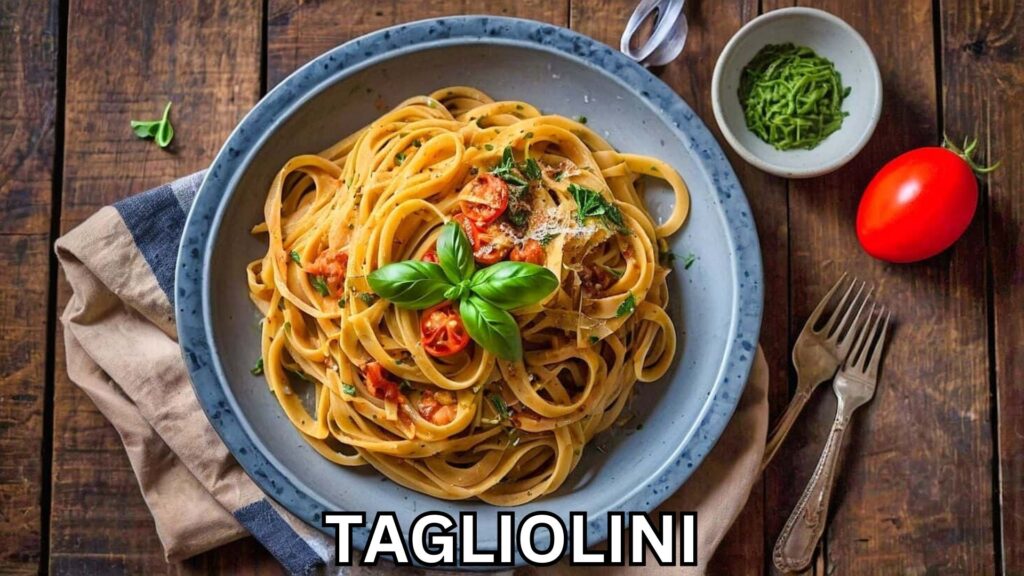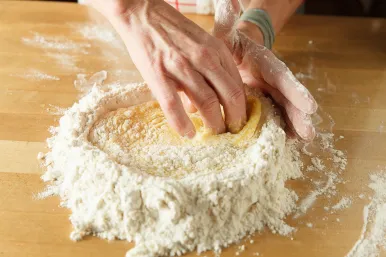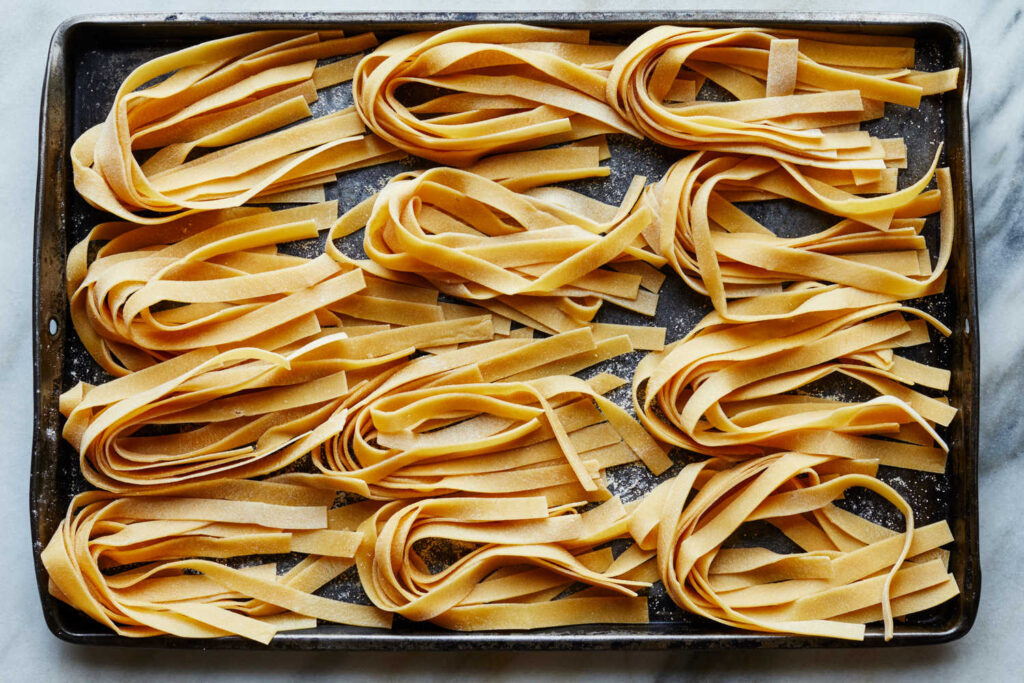
Tagliolini
Unmistakably Italian, even if its made only of flour and water, tagliolini has an honorable status among the different types of pasta in wonderful Italy. Known for its egg-based preparation and delicate texture, this pasta is perfect for a wide range of sauces, from light oils to decadent cream-based recipes. Whether making it fresh at home or using store-bought varieties, tagliolini brings an authentic touch of Italy to your table.
What is Tagliolini?
Tagliolini is a type of long, flat pasta that resembles fettuccine but is thinner. Made traditionally with eggs and flour, this pasta’s smooth texture allows it to absorb sauces effectively. It’s a staple in Italian cooking and is often served with luxurious ingredients like truffles or seafood.
Characteristics of Tagliolini
- Ribbon-like shape, thinner than fettuccine.
- Egg-based dough offers a rich flavor.
- Versatility for light or creamy sauces.
The History and Origins of Tagliolini
Tagliolini originated in Northern Italy, crafted as a staple pasta for special occasions. Over centuries, Italians transformed it into a symbol of culinary excellence, and people now celebrate it worldwide in both gourmet and casual dishes.
How to Make Fresh Tagliolini at Home
This wonderfully thin pasta shape originated in Piedmont, a northern Italian region, namely in the Langhe district immediately south of Alba. The locals call it tajarin. This pasta shape has long been a part of Piedmontese culinary history, thanks to its luscious yolk-rich dough, which marries nicely with smoother and slightly thinner pasta sauces, particularly a classic white truffle sauce created with locally obtained (and highly valued!) ingredients.
Do not mistake it for tagliatelle. While both are egg pasta cut into ribbon-shaped slices, they remain distinct. The name gives away their distinctions; the tagline means ‘cut’ in Italian, therefore the cut of these pasta forms distinguishes them. Tagliolini is substantially thinner than tagliatelle, measuring roughly 1mm thick and 3mm broad (slightly thicker than capellini).
The two pastas are often termed ‘egg pasta,’ but traditional tagliolini dough uses only egg yolks (along with a bit of wine or olive oil for moisture), making it distinct. Italians strongly oppose calling these two pasta types the same! The egg yolks create the pasta’s luscious richness. Certain Piedmont restaurants label their menu with ’40 yolk tajarin,’ indicating they use 40 egg yolks per kilogram of flour to make tagliolini (compared to the usual ten eggs per kilogram for standard egg pasta). Natural components like spinach, tomato, and saffron also add brilliant colors, creating a stunning deep yellow hue.
- Serves 2-3
- Prep and cook time: 1 hour
- Calories per serving: 416kcal
Equipment
- Wooden Board
- Fork
- Rolling pin or pasta machine
- Large sharp knife
Ingredients
- Six egg yolks
- 1 tablespoon of white wine or extra virgin olive oil 200 grams of semolina flour (or one hundred sixty grams of semolina plus forty grams of 00 flour)
Method
Step 1: Making the Dough
- On a polished wooden surface, make a heap of flour.
- Then, in the center of the mound create a large enough crater to accommodate all of the eggs yolks making sure that it is also fairly wide.
- Pour the yolks into the well. Use a fork to beat the egg mixture, gradually incorporating the flour from the edges of the well until the flour fully absorbs the egg. If the dough is still too dry, add some olive oil or white wine to soften it.

Step 2: Kneading the Dough
- Remove any leftover residue on the surface. After that, sprinkle some flour on the working table.
- To knead – push the palm of the hand into the dough ball while keeping the fingers bent backwards.
- Place both your hands on a piece of dough and push away forcefully from the body. With the motion, the hand should contain the dough waist at the conic region, rolling the dough to shape a dome.
- Flip over the paste and strike it with each of your knuckles in succession. This should be repeated up to 10 times.
- Make a ball again, and this time soundly stretch and knuckle the dough again. If necessary, add more flour to avoid excessive stickiness.
- Do the above for 10-20 minutes until the dough becomes even and lustrous.
- Shape the dough into a perfect ball.
- Cover the dough again with the plastic wrap and leave it at room temperature for 20-30 minutes before using it.

Step 4: Rolling the Pasta
*Because of its thinness, this pasta is considerably easier and quicker to roll out with a pasta machine, although it may still be done by hand.
- Lightly flour your surface.
- Shape the dough into a rough circle.
- Using the same method of rolling out a pastry dough, start from the middle and roll to the edges.
- Rotate the dough approximately a quarter of the way around and keep going until the disk is about 1 mm in thickness. Dust a very small amount of flour over the dough every time it sticks to the worktop or the rolling pin.
- As per Italian tradition, the thickness of the spread is such that one can read what is written underneath the layer even while using the thin tagliolina noodles.

Step 5: Cutting the Pasta
- Place one of the rolled-out sheets of pasta dough (now known as a sfoglia) on a clean, lightly floured work surface.
- Roll the dough over itself carefully, ensuring there is enough flour so it doesn’t stick.
- Trim the end edges with a sharp knife to make them even, then cut into 3mm-wide strips.
- Gently raise the spaghetti strips in the air and carefully set them on a tea towel, keeping them separate.
- Repeat with the remaining sheets of dough.
- You’re now ready to cook the pasta. If you want to prepare it later, check out our comprehensive tutorial on how to keep fresh pasta.

Step 6: Cooking the Tagliolini
- Now that you’ve created delicious, fresh tagliolini, it’s time to pair it with your favourite sauce!
- Bring a large pot of water to a boil. Once boiling, add a generous amount of salt.
- Add the pasta and cook for 1-2 minutes. *Keep a close eye on it; it cooks very quickly!
- Strain the pasta and combine with the sauce (adding little pasta water if necessary). Shave some Parmigiano Reggiano on top (unless the sauce is seafood-based), and enjoy! Good appetite!

FAQs
- What is tagliolini made of?
Tagliolini is traditionally made from eggs and flour, giving it a rich flavor and smooth texture.
- Can I use tagliolini in soups?
Yes, tagliolini works wonderfully in light, broth-based soups, enhancing their flavor without overpowering them.
- What is the cooking time for fresh tagliolini?
Fresh tagliolini cooks quickly, usually within 2–3 minutes, for a perfect al dente texture.
- Is tagliolini suitable for vegetarian recipes?
Absolutely! Pair tagliolini with sauces like garlic and olive oil or creamy mushroom sauce for a vegetarian-friendly meal.
- What’s the difference between tagliolini and fettuccine?
Tagliolini is thinner and more delicate, while fettuccine is broader and thicker. Both are ribbon-shaped pasta but serve different textures and sauces.





